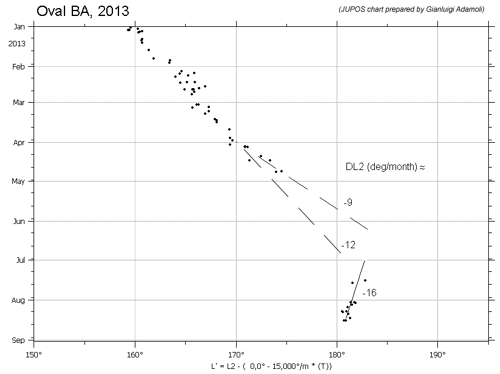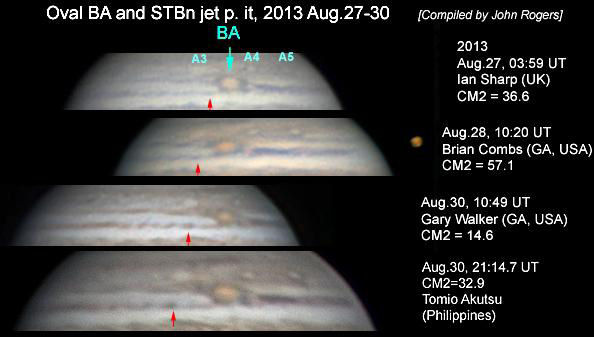Japanese (translated by Yuichi Iga)
Hello, Jupiter enthusiasts.
The new apparition of Jupiter is under way, so here are some notes on it -- in plain text below, and also attached as a PDF with images.
1. Filenames:
The start of the apparition is the ideal time for all observers who do not yet use the required format to start doing so. All images *must* have filenames which include the date in the order year-month-day, followed by an abbreviation of the observer's name or initials. The format used by the professional PVOL database is becoming most generally accepted:
jYYYY-MM-DD_HH-MM_filter_obs.jpg
for example:
j2013-11-01_01-56_rgb_ABC (which includes the time, 01:56 UTC, and observer ABC).
Alternatively, use our own preferred format:
2013nov01_ABC (and you can include several images in a single JPEG file).
Please do use one of these formats, with exactly the correct punctuation.
2. For people in the UK next week:
The European Planetary Science Congress is in London next week and there is an associated BAA meeting all day on Friday Sep.13. This will be a workshop on "Amateur Contributions to Solar System Studies". Several of our European colleagues will be there giving demonstrations of the use of the JUPOS and fireball-detection software. So it will be a unique opportunity, and anyone is welcome. Details on the BAA web site:
http://britastro.org/
--& follow >Meetings >Upcoming meetings;
--or go directly to:
http://britastro.org/baa/index.php?option=com_gcalendar
&view=event
&eventID=dGFxMTlxOHFlNG5jOWNvcml0aGI1aHE3OG8gNWFtNDU5dGRhYm9jcmR1cThpOThoZXVpZmdAZw
&start=1379026800
&end=1379113200
&gcid=2
&Itemid=100005
3. Jupiter at the start of the new apparition:

Click for the original size
Attached is a map made by Marco Vedovato from recent images, and here are some notes on some features of interest, including first results from JUPOS analysis by Gianluigi Adamoli and Michel Jacquesson.
The planet looks generally normal (quite a change from a year ago!).
The NNTB has largely reappeared. NN-LRS-1 is still a large reddish oval, at L2 = 177.
The NTB, following last year’s revival, is in a typical state with a N component consisting of narrow grey streaks, and a S component which is bland and pale orange.
The NEB has returned to a normal width, with some dark barges along its irregular N edge, and some typical large dark formations on its S edge.
The SEB is normal, and the usual ‘rifting’ f. the GRS is extensive and active.
The GRS is still strongly orange and isolated, indicating a lack of incoming SEBs disturbances.
The STB comprises a single long dark segment, f. oval BA, to be discussed below.
The nine long-lived SSTB white ovals are all still present.
Major spots of interest:
In the NTropZ, the very long-lived white spot Z (WSZ) is still present, at L2 = 226, although it has quite low contrast against the bright NTropZ. It is still rapidly prograding, with DL2 = -23 deg/month. (This is not as fast as its motion last autumn, when it peaked at -42 deg/month.) It will soon be interacting with two dark barges on NEBn. In Chris Go’s image on Aug.31, WSZ is remarkably methane-bright.
In the SEB, the strange long-lived light patch has now almost reached the p. end of the Red Spot Hollow. In the latest images (Chris Go and Rich Jakiel, Aug.31), it has resolved into a simple oval form, probably an underlying cyclonic oval as has been suggested by a few v-hi-res images in the past. Its interaction with the Red Spot Hollow over the coming days or weeks will be very interesting to observe.
In the STB, oval BA is still a well-defined orange oval (see image set and JUPOS chart on next page), and we can now see the aftermath of the collision with STB dark segment D in the last apparition.
As we predicted*, oval BA has accelerated dramatically! Initially, last apparition, it did not do so** - indeed it may even have slowed down (from DL2 = -12 deg/month to ~-9 deg/month). This was probably because, when the incoming STB dark segment arrived f. oval BA, it did not form a long turbulent dark segment as in previous such events, but instead broke up into a chain of cyclonic ovals. Since solar conjunction, this chain has been replaced by a long dark segment after all, and accordingly, oval BA has accelerated at last (to DL2 ~ -16 deg/month).
Moreover, the other expected consequences of the collision are also evident: a very dark collar around oval BA, and dark spots emitted on the STBn jetstream p. it, and in the STZ f. it. The attached image set shows how the STBn p. oval BA, which was tenuous last year, is now much darker with tiny prograding spots (red arrow).
One other feature in the STB deserves attention: a very faint blue-grey streak at L2 ~ 253. This evolved from a very dark spot in 2012, and we have suggested that it is the next STB structured sector, so it will be called STB segment E or, more familiarly, the ‘STB Ghost’, since it closely resembles the earlier ‘STB Remnant’. (It is best shown in Damian Peach’s image on Sep.2.)
*[Refs to our previous reports - see PDF version]
*For the background to this event, see our big long-term report on the S.Temp. domain:
http://www.britastro.org/jupiter/stemp2013.htm
and our report last apparition:
http://www.britastro.org/jupiter/2012_13report10.htm
**For our last bulletin on the collision in early 2013, see:
http://www.britastro.org/jupiter/2012_13report11.htm

Click for the original size

John Rogers
2013 Sep.3
|
木星:2013/14年観測期の最初の報告
Jupiter: first bulletin for 2013/14 apparition
September 3, 2013
John Rogers (British Astronomical Association)
木星愛好家の皆さんへ、
木星の新しい観測期が進行しているので、下記にテキストで、添付に画像を持つPDFファイルとして、いくつかの注意を述べる。
1. ファイル名:
観測を開始するためにまだ要求された形式を使っていない観測者にとって、観測期の開始は良いタイミングである。全ての画像は、年-月-日の順番の日付と観測者の名前の省略形かイニシャルが後ろに続くファイル名でなければならない。プロのPVOLデータベースで用いられる形式は最も一般的に受け入れられている。
jYYYY-MM-DD_HH-MM_filter_obs.jpg
例えば、
j2013-11-01_01-56_rgb_ABC (これは時刻01:56 UTCと観測者ABCを含む)。
代わりに、我々の優先形式を用いると、
2013nov01_ABC (一つのJPEGファイルに複数の画像を含むことができる)。
正確に正しい区切りを持つ、これらの一つの形式をどうか使って欲しい。
2. 来週、英国に居る人のために:
来週、欧州惑星科学会議がロンドンであり、9月13日(金)の終日に関連するBAAミーティングがある。これはワークショップ『太陽系研究へのアマチュアの貢献』である。我々の欧州の協力者の何人かは、そこでJUPOSと火球検出ソフトウェアのデモを行う。だから、これはまたとない機会であり、誰でも参加できる。詳しくはBAA webサイトを参照。
http://britastro.org/
--ここから、 >Meetings >Upcoming meetings;
--あるいは、直接に:
http://britastro.org/baa/index.php?option=com_gcalendar
&view=event
&eventID=dGFxMTlxOHFlNG5jOWNvcml0aGI1aHE3OG8gNWFtNDU5dGRhYm9jcmR1cThpOThoZXVpZmdAZw
&start=1379026800
&end=1379113200
&gcid=2
&Itemid=100005
3. 新しい観測期の開始時の木星:

Click for the original size
添付は最近の画像からMarco Vedovatoによって作成されたマップで、Gianluigi AdamoliとMichel JacquessonによるJUPOS解析の最初の結果を含む、興味あるいくつかの模様についての注意を述べる。
木星は一般的に普通に見える(1年前からかなりの変化)。
NNTBは広く再出現している。NN-LRS-1は今も大きな赤味がかった白斑で、L2=177度に位置する。
昨年の復活に引き続いて、NTBは、狭い灰色のストリークから構成される北組織と、穏やかで淡いオレンジ色の南組織を持つ典型的な状態である。
NEBは通常の幅に戻っていて、不規則な北端に沿っていくつかのダーク・バージと、南端にいくつかの典型的な大きな暗部がある。
SEBは普通で、大赤斑後方の通常のリフト領域は広く活動的である。
大赤斑は今も強いオレンジ色で孤立していて、これは新しいSEBs攪乱がないことを示している。
STBは、後述するように、BA後方に単一の長いダーク・セグメントを構成する。
9個の永続するSSTB白斑は今も全て存在している。
興味ある主要な斑点:
NTropZには、非常に長寿命な白斑Z(WSZ)が今もL2=226度に存在しているが、しかし明るいNTropZに対してかなり低コントラストである。この白斑はDL2=-23度/月で今も高速で前進している(DL2=-42度/月のピークだった、昨年秋の動きほど速くない)。まもなくNEBnの2個のダーク・バージは相互作用するだろう。8月31日のChris Goの画像では、WSZは明らかにメタン・ブライトである。
SEBには、奇妙で長寿命な明るいパッチ(light patch)が現在ほとんど大赤斑孔の前端に達している。最近の画像(8月31日のChris GoとRich Jakiel)では、単一の斑点、おそらく過去の数少ない超高解像度画像で示唆されたように基本となる低気圧性白斑に分解されている。数日か数週間に渡る大赤斑孔との相互作用は観測に非常に興味深い。
STBには、白斑BAが今もはっきりとしたオレンジ色の白斑で(次ページの画像とJUPOSチャートを参照)、現在我々は昨年の観測期のSTBのダーク・セグメントDとの衝突の余波を見ることができる。
予想したように(*)、白斑BAは劇的に加速している。昨年の観測期の当初、そのように速くはなく(**)、たしかに減速さえしたかもしれない(DL2=-12度/月からDL2=-9度/月へ)。これはおそらく、新しいSTBのダーク・セグメントが白斑BAの後方に達した時に、以前の現象のように長い乱流のダーク・セグメントを形成しなかったが、代わりに低気圧性白斑のチェインに分解したからであろう。太陽との合以降、このチェインは結局長いダーク・セグメントに置き換えられて、それに応じて白斑BAは最終的に加速した(DL2=約-16度/月に)。
さらに、他の衝突の予想結果も明らかで、白斑BAの周りの非常に濃いカラー(えり)や、白斑前方のSTBnジェット気流と白斑後方のSTZに放出された暗斑が見られる。添付の画像は、昨年は薄かった白斑BA前方のSTBnがどのように小さな前進する暗斑を伴ってかなり濃くなったかを示す(赤矢印)。
STZのもう一つの模様、L2=約253度の非常に淡い青灰色のストリークは注目に値する。これは2012年に非常に濃い暗斑から発達したし、これが以前の‘STB Remnant(STB残留物)’ととても似ているので、これが次のSTBの構造化セクターであり、だからこれをSTBセグメントE、あるいは親しみをこめて‘STB Ghost(STB痕跡)’と呼ぶことを提案している。
*は我々の以前のレポートを示す。
(*) この現象のバックグラウンドについて、我々の南温帯領域の長期レポートを参照。
http://www.britastro.org/jupiter/stemp2013.htm
日本語訳 http://alpo-j.asahikawa-med.ac.jp/kk13/j130716r.htm
それと昨年の観測期の我々のレポートを参照。
http://www.britastro.org/jupiter/2012_13report10.htm
日本語訳 http://alpo-j.asahikawa-med.ac.jp/kk13/j130320r.htm
(**) 2013年初めの衝突についての我々の最新報告。
http://www.britastro.org/jupiter/2012_13report11.htm
日本語訳 http://alpo-j.asahikawa-med.ac.jp/kk13/j130514r.htm

Click for the original size

John Rogers
2013 Sep.3
|


